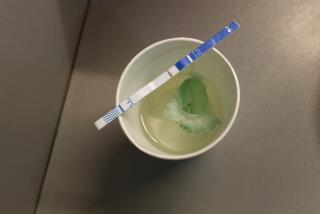‘iKnife’ device analyzes surgical smoke to ID cancers

A new device that analyzes the smoke that arises when an electrosurgical tool slices through or cauterizes flesh may help physicians determine, during a surgery, whether tissues they’re removing are cancerous or not.
Using mass spectrometry to determine the components of the aerosolized tissue, chemist Zoltan Takats and colleagues at the medical school at Imperial College London and other institutions found that they could tell if tissues were cancerous or not in a matter of seconds. Lipid components in the smoke created from different types of tissues had characteristic signatures.
Takats and his team wrote about their intelligent knife, or “iKnife,” in a study published online Wednesday by the journal Science Translational Medicine.
If the tool and technique work well in clinical trials and can get regulatory approval, Takats said, it could speed surgeries considerably.
Sometimes, during the course of surgery to remove a tumor, an operating team will have questions about whether the tissues they encounter are cancerous or normal.
Today, surgeons must take a break from the operation to send a tissue sample to a pathology lab for analysis. It can take a half an hour or more to get a read back from the lab, Takats said -- time during which the patient must remain under anesthesia while the operating team waits.
A surgeon using an intelligent knife could know what kind of tissue he or she was dealing with almost instantaneously, and make decisions about how to proceed on the spot.
“One can sample a bit of tissue and the result is displayed on the screen in a second. It allows fast analysis and more sampling points,” Takats said.
Seeking to show in the current study that the intelligent-knife technology worked, the team analyzed several thousand cancerous and normal samples from 302 patients, constructing a database of tissue signatures.
Then they gave intelligent knives to surgeons, who recorded data from the smoke generated during 91 operations. Analyzing the signatures, the researchers found that they were able to tell the difference between cancerous and normal tissue, and between different types of cancers.
The samples were also analyzed using traditional pathology techniques; the iKnife findings matched those with 100% accuracy, the team reported.
“We proved that it is at least as good as the currently accepted technology,” Takats said.
The intelligent knife doesn’t work perfectly in all cases. For instance, Takats said, it’s hard for it to analyze smoke from tissues that are harder to evaporate, including skin and bone. But when cancers originating in skin and bone spread to other parts of the body, they too can be easily identified, he said.
Dr. Joseph Kim, a cancer surgeon at City of Hope in Duarte, Calif., said he thought the study was interesting, but that he wasn’t sure the new technology would be useful in his own work.
“It’s forcing you to burn tissues in areas where you wouldn’t burn,” he said. “The type of operations I do, I’m not sure I’d want to change.”
For instance, Kim, who performs surgeries on gastrointestinal cancers, said he wouldn’t use an electrosurgical tool to cut a colon in half. But he said the intelligent knife might be useful for surgeons who use the cutting-and-cauterizing equipment more, such as breast cancer surgeons.
Kim said he and his colleagues had long joked about the smoke that’s created during surgeries, figuring that it’s probably dangerous to inhale.
“We’ve all thought of the smoke in a different way, but perhaps it has another potential use,” he said.







